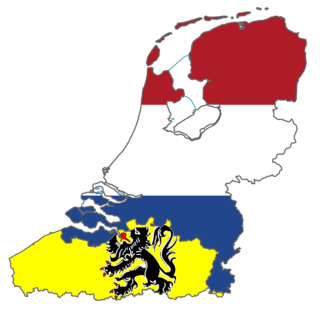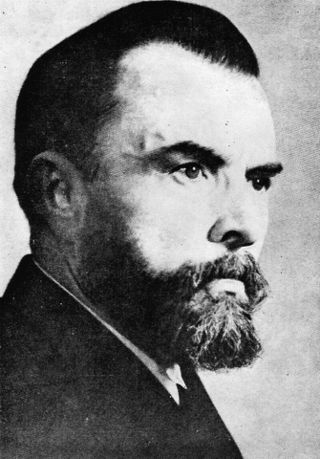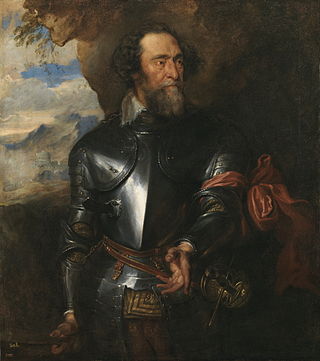
The Orde van den Prince or Order of the Prince is a Flemish-Dutch society for the promotion of the language and culture of the Dutch-speaking Low Countries (Flanders and Netherlands). Each month members meet on fixed locations, except during summer.

The Orde van den Prince or Order of the Prince is a Flemish-Dutch society for the promotion of the language and culture of the Dutch-speaking Low Countries (Flanders and Netherlands). Each month members meet on fixed locations, except during summer.
The organization was founded in November 1955, by the lawyer Guido van Gheluwe from Kortrijk. The name of the society is derived from William the Silent. He was chosen because of his role in the history of the Netherlands and its tolerance (relative to the standards of his time). The logo of the Orde van den Prince is the capital letter P, surrounded by the words Amicitia (friendship) and Tolerantia (tolerance).
The organization shows a steady increase in membership and now consists of 93 departments: 54 in Flanders, 4 in Wallonia, 29 in the Netherlands and 6 in other countries. Membership, currently almost 3,000, is by invitation only.

Flanders is the Dutch-speaking northern portion of Belgium and one of the communities, regions and language areas of Belgium. However, there are several overlapping definitions, including ones related to culture, language, politics, and history, and sometimes involving neighbouring countries. The demonym associated with Flanders is Fleming, while the corresponding adjective is Flemish, which is also the name of the local dialect. The official capital of Flanders is the City of Brussels, although the Brussels-Capital Region that includes it has an independent regional government. The powers of the government of Flanders consist, among others, of economic affairs in the Flemish Region and the community aspects of Flanders life in Brussels, such as Flemish culture and education.

Zeelandic Flanders is the southernmost region of the province of Zeeland in the south-western Netherlands. It lies south of the Western Scheldt that separates the region from the remainder of Zeeland and the Netherlands to the north. Zeelandic Flanders is bordered to the south and to the east by Belgium.

The Flemish Movement is an umbrella term which encompasses various political groups in the Belgian region of Flanders and, less commonly, in French Flanders. Ideologically, it encompasses groups which have sought to promote Flemish culture and the Dutch language as well as those seeking greater political autonomy for Flanders within Belgium. It also encompassed nationalists who seek the secession of Flanders from Belgium, either through outright independence or unification with the Netherlands.

Greater Netherlands is an irredentist concept which unites the Netherlands, Flanders, and sometimes Brussels. Additionally, a Greater Netherlands state may include the annexation of the French Westhoek, Suriname, formerly Dutch-speaking areas of Germany and France, or even the ethnically Dutch and/or Afrikaans-speaking parts of South Africa, though such variants are mostly limited to far-right groups. A related proposal is the Pan-Netherlands concept, which includes Wallonia and potentially also Luxembourg.

The Vlaamsch Nationaal Verbond, widely known by its acronym VNV, was a Flemish nationalist political party active in Belgium between 1933 and 1945. It became the leading force of political collaboration in Flanders during the German occupation of Belgium in World War II. Authoritarian by inclination, the party advocated the creation of a "Greater Netherlands" (Dietsland) combining Flanders and the Netherlands.

The Dutch are an ethnic group native to the Netherlands. They share a common ancestry and culture and speak the Dutch language. Dutch people and their descendants are found in migrant communities worldwide, notably in Aruba, Suriname, Guyana, Curaçao, Argentina, Brazil, Canada, Australia, South Africa, New Zealand and the United States. The Low Countries were situated around the border of France and the Holy Roman Empire, forming a part of their respective peripheries and the various territories of which they consisted had become virtually autonomous by the 13th century. Under the Habsburgs, the Netherlands were organised into a single administrative unit, and in the 16th and 17th centuries the Northern Netherlands gained independence from Spain as the Dutch Republic. The high degree of urbanisation characteristic of Dutch society was attained at a relatively early date. During the Republic the first series of large-scale Dutch migrations outside of Europe took place.

Verdinaso, sometimes rendered as Dinaso, was a small fascist political movement active in Belgium and, to a lesser extent, the Netherlands between 1931 and 1941.

Staf De Clercq was a Flemish nationalist collaborator, co-founder and leader of the Flemish nationalist Vlaamsch Nationaal Verbond.

The Flemish Diamond is the Flemish reference to a network of four metropolitan areas in Belgium, three of which are in the central provinces of Flanders, together with the Brussels Capital Region. It consists of four agglomerations which form the four corners of an abstract diamond shape: Brussels, Ghent, Antwerp and Leuven. Over 5 million people live in this area, with a population density of about 820 per km2.
Flemish literature is literature from Flanders, historically a region comprising parts of present-day Belgium, France and the Netherlands. Until the early 19th century, this literature was regarded as an integral part of Dutch literature. After Belgium became independent from the Netherlands in 1830, the term Flemish literature acquired a narrower meaning and refers to the Dutch-language literature produced in Belgium. It remains a part of Dutch-language literature.

Matthias Edward Storme is a Belgian lawyer, academic and conservative philosopher.

Flemish painting flourished from the early 15th century until the 17th century, gradually becoming distinct from the painting of the rest of the Low Countries, especially the modern Netherlands. In the early period, up to about 1520, the painting of the whole area is typically considered as a whole, as Early Netherlandish painting. This was dominated by the Flemish south, but painters from the north were also important. Dutch and Flemish Renaissance painting, of which Antwerp became the centre, covers the period up to about 1580 or later, by the end of which the north and south Netherlands had become politically separated. Flemish Baroque painting was especially important in the first half of the 17th century, dominated by Rubens.

The Renaissance in the Low Countries was a cultural period in the Northern Renaissance that took place in around the 16th century in the Low Countries.
Guido Richard van Gheluwe was a Belgian lawyer and founder of the Orde van den Prince. He founded the Orde van den Prince on 2 November 1955, and was its president from 1955 until 1964. Since July 1965 he bears the honorary title of President Founder of the Orde van den Prince.
De Warande is a Flemish club, located in Brussels, Belgium. The club was founded in Brussels in 1988.
The partition of Belgium is a hypothetical situation, which has been discussed by both Belgian and international media, envisioning a split of Belgium along linguistic divisions, with the Flemish Community (Flanders) and the French-speaking Community (Wallonia) becoming independent states. Alternatively, it is hypothesized that Flanders could join the Netherlands and Wallonia could join France or Luxembourg.

Hendrik van den Bergh, 1573 to 22 May 1638, was a Flemish noble and professional soldier. Hereditary lord of Stevensweert, from 1618 to 1637 he was also stadtholder of Upper Guelders, the only part of Guelders to remain loyal to Habsburg Spain during the Eighty Years War. Known as a brave and resourceful cavalry commander, he spent most of his career with the Spanish Army of Flanders and became its Maestre de campo in 1628. Accused of treachery after the loss of Den Bosch in 1629, he defected to the Dutch Republic following the 1632 Conspiracy of Nobles.

Flemish people or Flemings are an ethnic group native to Flanders, Belgium, who speak Flemish Dutch. Flemish people make up the majority of Belgians, at about 60%.

The Dutch Republic Lion was the badge of the Union of Utrecht, the Republic of the Seven United Netherlands, and a precursor of the current coat of arms of the Kingdom the Netherlands.

The Calvinist Republic of Ghent was a Calvinist republic that existed between 1577 and 1584 in the Flemish independent city of Ghent.